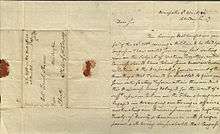John Beatty (Continental Congress)
John Beatty (December 10, 1749 – May 30, 1826) was an American physician and statesman from Princeton, New Jersey.[1][2]
John Beatty | |
|---|---|
.tif.jpg) | |
| Secretary of State of New Jersey | |
| In office 1795–1805 | |
| Governor | Richard Howell Joseph Bloomfield |
| Preceded by | Samuel W. Stockton |
| Succeeded by | James Linn |
| Member of the U.S. House of Representatives from New Jersey's At-large district | |
| In office 1793 – 1795 alongside Elias Boudinot, Abraham Clark, Jonathan Dayton, and Lambert Cadwalader | |
| Preceded by | Elias Boudinot, Abraham Clark, Jonathan Dayton, and Aaron Kitchell |
| Succeeded by | Jonathan Dayton, Aaron Kitchell, Mark Thomson, Thomas Henderson, and Isaac Smith |
| Speaker of the New Jersey General Assembly | |
| In office 1789–1790 | |
| Preceded by | Benjamin Van Cleve |
| Succeeded by | Jonathan Dayton |
| Personal details | |
| Born | December 10, 1749 Bucks County, Pennsylvania |
| Died | May 30, 1826 (aged 76) Trenton, New Jersey |
| Relations | John Reading (grandfather) James Clinton (great-grandfather) |
| Parents | Charles Clinton Beatty Anne Reading |
| Alma mater | College of New Jersey |
| Occupation | Physician, politician |
Early life
He was born in Bucks County, Pennsylvania on December 10, 1749.[1] Beatty was the oldest of ten children of Irish born Rev. Charles Clinton Beatty and Anne (née Reading) Beatty, who were married in 1746. His father was a Presbyterian minister who did missionary work among the Native Americans.
His maternal grandfather was John Reading, president of the New Jersey Provincial Council and acting Governor of the Province of New Jersey.[3] His paternal grandparents were John Beatty and Christiana (née Clinton) Beatty.[4] John's grandmother was the daughter of James Clinton and the sister of Charles Clinton (himself the father of Revolutionary War Major General James Clinton and Vice President George Clinton, and the grandfather of New York Governor DeWitt Clinton).[5][6]
Beatty graduated from the College of New Jersey (later known as Princeton University) in 1769.[7] He was a student of Founding Father Benjamin Rush.[8]
Career

Beatty became a doctor and opened his first practice in Hartsville, Pennsylvania.[9] He rose to the rank of major in the 6th Pennsylvania Regiment of the Continental Army during the American Revolutionary War. He was captured at the surrender of Fort Washington on 16 November 1776. After his exchange, he was appointed Commissary General for Prisoners with the rank of colonel.[10][11]
By the end of the war he had become a resident of New Jersey, serving as a member of the New Jersey Legislative Council (now the New Jersey Senate) from 1781 to 1783, representing Middlesex County,[12] and delegate from that state to the Continental Congress in 1784 and 1785.[1]
He was the speaker of the New Jersey General Assembly from 1789 to 1790, and a member of the U.S. House of Representatives in the Third Congress from 1793 to 1795. He later served as Secretary of State of New Jersey from 1795 to 1805.[1]
Personal life
Beatty was married to Catherine DeKlyn (1773–1861), the daughter of Mary (née Van Sant) DeKlyn and Barnt DeKlyn, who became wealthy selling textiles to the Continental Army during the American Revolution.[13] Together, they were the parents of Robert Beatty and William Beatty.[14]
Beatty was a member of the Society of the Cincinnati in the State of New Jersey, and served as the organization's treasurer from 1823 until his death on May 30, 1826 in Trenton in Mercer County, New Jersey.[15][16]
Legacy
The Presbyterian Historical Society in Philadelphia, Pennsylvania, has a collection of personal papers, including diaries, correspondences and genealogical notes, related to the Beatty Family. Besides John Beatty's papers, the collection also includes journals by his father, Charles Clinton Beatty, who served as an early missionary with George Duffield among Native Americans.[3]
References
- "BEATTY, John - Biographical Information". bioguide.congress.gov. Biographical Directory of the United States Congress. Retrieved 22 May 2018.
- Mays, Terry M. (2005). Historical Dictionary of Revolutionary America. Scarecrow Press. p. 24. ISBN 9780810853898. Retrieved 22 May 2018.
- "Guide to the Beatty Family Papers". www.history.pcusa.org. Presbyterian Historical Society. Retrieved 22 May 2018.
- Jordan, John Woolf (1913). Genealogical and Personal History of the Allegheny Valley, Pennsylvania. Lewis Historical Publishing Company. p. 721. Retrieved 22 May 2018.
- Bergen, Tunis Garret (1915). Genealogies of the State of New York: A Record of the Achievements of Her People in the Making of a Commonwealth and the Founding of a Nation. Lewis Historical Publishing Company. Retrieved 18 July 2017.
- Moore, Charles B., "Introductory Sketch to the History of the Clinton Family", The New York Genealogical and Biographical Record, (Richard Henry Greene at al, eds.), New York Genealogical and Biographical Society, 1880
- "To George Washington from John Beatty, 28 April 1789". founders.archives.gov. Founders Online. Retrieved 22 May 2018.
- Gansevoort Jr., Peter (2014). Hero of Fort Schuyler: Selected Revolutionary War Correspondence of Brigadier General Peter Gansevoort, Jr. McFarland. p. 254. ISBN 9781476616803. Retrieved 22 May 2018.
- Bulletin of the History of Medicine. Johns Hopkins University Press. 1958. pp. 38–41. Retrieved 22 May 2018.
- Heitman, Francis Bernard (1914). Historical Register of Officers of the Continental Army During the War of the Revolution, April 1775, to December, 1783. Rare Book Shop Publishing Company. p. 95. Retrieved 22 May 2018.
- Purcell, L. Edward. Who Was Who in the American Revolution. New York: Facts on File, 1993. ISBN 0-8160-2107-4.
- Jensen, Merrill; DenBoer, Gordon; Becker, Robert A. (1976). The Documentary History of the First Federal Elections, 1788-1790. Univ of Wisconsin Press. p. 52. ISBN 9780299106508. Retrieved 22 May 2018.
- "New Jersey and National Registers of Historic Places - Mercer County" (PDF). New Jersey Department of Environmental Protection - Historic Preservation Office. March 1, 2011. p. 9. Archived from the original (PDF) on December 3, 2010. Retrieved March 28, 2011.
- Daughters of the American Revolution Lineage Book. Daughters of the American Revolution. 1935. p. 99. Retrieved 22 May 2018.
- "John Beatty | The Society of the Cincinnati in the State of New Jersey". njcincinnati.org. Retrieved 14 May 2019.
-

External links
- United States Congress. "John Beatty (id: B000282)". Biographical Directory of the United States Congress.

- John Beatty at Find a Grave
| U.S. House of Representatives | ||
|---|---|---|
| Preceded by Elias Boudinot, Abraham Clark, Jonathan Dayton, and Aaron Kitchell on a General ticket |
Member of the U.S. House of Representatives from New Jersey's at-large congressional district alongside Elias Boudinot, Abraham Clark, Jonathan Dayton, and Lambert Cadwalader on a General ticket 1793 – 1795 |
Succeeded by Jonathan Dayton, Aaron Kitchell, Mark Thomson, Thomas Henderson, and Isaac Smith on a General ticket |
| Political offices | ||
| Preceded by Benjamin Van Cleve |
Speaker of the New Jersey General Assembly 1789 – 1790 |
Succeeded by Jonathan Dayton |
| Preceded by Samuel W. Stockton |
Secretary of State of New Jersey 1795 – 1805 |
Succeeded by James Linn |